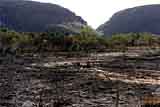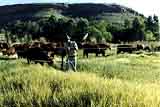Index of articles and links
Grasslands and grazers evolved together in the world's seasonally dry and arid (brittle) environments. Healing this land usually involves managing livestock to perform the ecosystem functions once performed by wild animals. This works even on severely damaged and eroded land, and in places where no topsoil remains.
Kachana Pastoral Co.
November 1992: An Australian wetland devastated by feral livestock and repeated fires.
June 1999: Cattle that helped restore the area graze during the dry season. With plenty to eat, wildlife is returning. Article. |
Monitoring ecosystem health
Landscape monitoring (articles). Ways to assess land's health, discover whether it's improving or deteriorating, and determine what it needs to become or remain healthy.Healing land with managed grazing
How can grazing heal land? A short introduction to the basics of how and why it works, with photos.Grazing as an ecological tool (articles) lists links to in-depth coverage of this still-controversial subject.
Soil and soil-building
Revegetating soilless land (articles). Soil-building is a vital part of revegetating "impossible" sites where topsoil has been lost or never existed in the first place.Improving soil health and building new soil (articles). Soil health is vital to ecosystem health. How to use managed grazing to promote new soil formation, up to several cm per year.
Working with soil life (articles). Soil organisms, particularly fungi that help plant roots absorb nutrients, are vital to maintaining soil health. The organisms present affect which nutrients are available and which plants can grow and thrive. Soil life can be seeded, its activity measured, and its health promoted by good management.
Related articles and links

